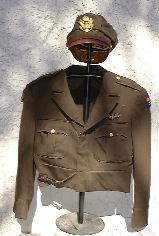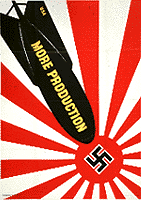 THE RISE AND DEMISE
THE RISE AND DEMISE 
OF THE AAF BATTLE JACKET
By: Col. Royal Frey
|
� � Being stationed on a RAF base certainly was different in many ways. One pertained to the uniforms the RAF personnel wore. They not only had a blouse similar to the type we AAF fellows wore, but they had a battle jacket cut off at the waist that they could wear in place of the RAF blouse. In fact, they seemed to wear the battlejacket most of the time and they even flew in it; try doing that in a blouse, particularly when hooking up the leg straps of a parachute harness. � � On Oct.2, I went over to Kittering to the US Army Post Exchange and purchased two pair of Army green officer trousers, size 46. I then took them to a local tailor in Kettering and told him to make a RAF-style battlejacket from the trousers, with small lapels and the hidden buttons down the front and on the sleve cuffs. I went back to the tailor on 22 Oct. and picked up my new battlejacket-from that day, I was rarely without it except when I had it in the cleaners. In my opinion, it was far more comfortable and practical, and much "sharper looking", than the Class A blouse. � � As the time approached when we were to go on ops, I sewed into the shoulder lining of my battlejacket two of the miniature brass compasses that S-2 provided to us. I also removed the cuff buttons and sewed on the brass buttons that made up a compass - one button had a small pin projecting up from the center and the other one, with two white dots to indicate "north", had a small dimple in the center that fit down over the pin of the first one. But the joke turned out to be on me - the day I was shot down over Germany, my battlejacket was in the post cleaning shop, so those compasses were never of any use to me. � � By the time I was shot down, 10 February 1944, it seemed that about every AAF flyer one would see on the streets of nearby towns would be wearing AAF battlejackets. And when I ended up in POW camp, there were a lot to be seen there too, because the Germans didn't confiscate items that a fellow had purchased, only GI items that were standard issue. But during the summer of 1944, things began to change - we started getting in fellows who were wearing a style of jacket that looked to me if someone had cut off the bottom of a Class A blouse, with all its brass buttons down the front and large lapels. These new fellows called these cut-off blouses "Ike Jackets" and I wondered how Gen. Eisenhower had gotten into the act - battlejackets were for AAF types, not ground pounders.Seriously, I felt just a little bit irratated that my beloved battlejacket had been superseded by something not nearly as good looking.  An "Ike Jacket" worn by a bombardier in the 15th.AF � � When I got back to King's Cliffe in mid-May 1945 after the Russins had liberated my POW camp, there were very few "true" style battlejackets to be seen - most of the old timers who hadn't been shot down had already gone home. (Yeah, Riemensnider had it so good that nothing could get him to give it up, so he was no exception.) � � Talking about an exception, let me give you another one. The US Army officer uniform was refered to as "pinks and greens" with the pinks being gray-cast trousers and the green being the blouse (or our AAF-type battlejacket.) Whne we got to England and began buying "pink" trousers made from British-produced cloth, they actually had a slight pink cast to them. Well, when all us fellows in the 20th. ordered our "green" battlejackets, Roy Scrutchfield pulled a fast one on us -- he ordered a PINK battlejacket. When he put it on with a pair of matching pink trousers, he was without a doubt the sharpest looking pilot I saw during my days with the 20th. in England. And when he substituted a pink overseas cap for his green crusher, he was a real sight to behold. � � Anyway, in 1949 I was flying P-51s in the Ohio ANG and still wearing my old WWII battlejacket - I just hated to give it up. However, on Thanksgiving Day weekend in 1949, the housetrailer in which Bettie and I were living while I was attending Ohio State caught on fire and all of my WWII uniforms were destroyed. There went my green battlejacket. I've often wondered what happened to Scrutch's pink one. Reprinted from King's Cliffe Remembered |
RETURN TO THE FREY BIO � RETURN TO THE 20TH. FG
� �

Click On The Poster To E-Mail Us!
Unless otherwise noted, all content � copyright The Art of Syd Edwards 1998-1999. All rights reserved and reproduction is prohibited.
